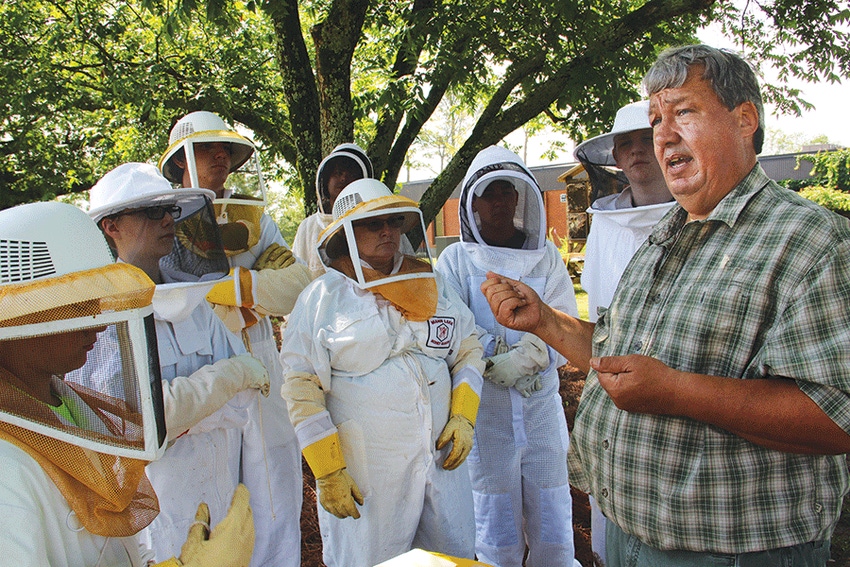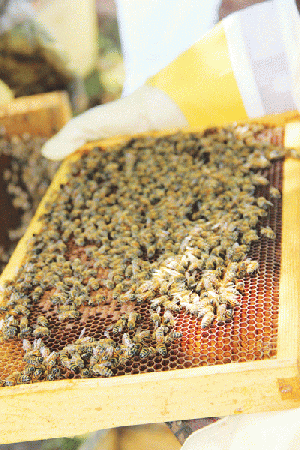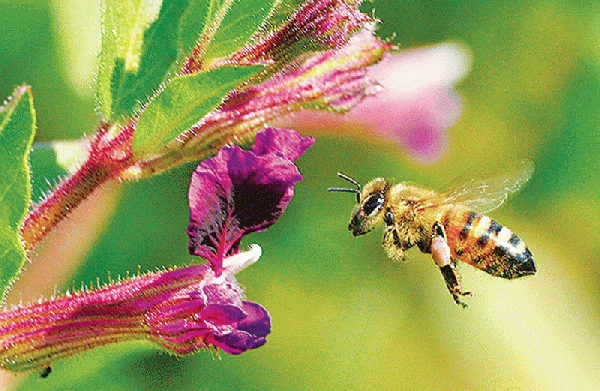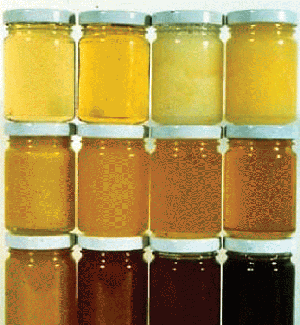
“In the long history of man’s relationship with honey bees, going back to Aristotle, who wrote the first manual on beekeeping, there have been many instances of unexplained colony losses — and many occurred long before agricultural pesticides came into widespread use."

First of a series
Environmental and anti-pesticide activists have made honey bee deaths “the poster child” of their ongoing crusade against ag chemicals, particularly neonicotinoids, says Jeff Harris.

The beekeeping landscape “has been changed forever” by the tiny varroa mite, says Jeff Harris. The mite vectors diseases that have wiped out honey bee colonies worldwide.
The beekeeping landscape “has been changed forever” by the tiny varroa mite, says Jeff Harris. The mite vectors diseases that have wiped out honey bee colonies worldwide.But the Mississippi State University Extension/research apiculturist says pesticides are just a part of the cause of colony collapse disorder, which has wiped out thousands of bee colonies in the U.S. and worldwide in recent years. “I would never say pesticides don’t harm bees — that’s what they’re made to do, kill insects — but at the same time I wouldn’t single them out as the predominant cause of bee losses.
“In the long history of man’s relationship with honey bees, going back to Aristotle, who wrote the first manual on beekeeping, there have been many instances of unexplained colony losses — and many occurred long before agricultural pesticides came into widespread use.
“There have also been episodes of losses with a known cause. In the early 1900s, a bacterial disease, American foulbrood, was so contagious that the only way to deal with it was to burn hives that were contaminated. Then, there were gut parasites; Nosema, which wiped out colonies in colder climates; and tracheal mites from Asia, which were devastating in the 1980s.
IT’S FREE! Stay informed on what’s happening in Mid-South agriculture: Subscribe to Delta Farm Press Daily.
“In the Deep South in recent years, we’ve had to contend with economic loss of beekeeping equipment by two pests, the Greater Wax Moth and the Small Hive Beetle from South Africa. Both of these pests can overrun colonies weakened by other diseases. Beekeepers have been confronted with many non-pesticide related situations over the decades that have caused large-scale colony losses.”
Despite all the anti-pesticide hoopla by activists and the mainstream media about pesticides and their impact on honey bees, Harris and other experts say it’s the tiny varroa mite, combined with other pests, parasites, and stresses —including putting colonies of bees on trucks and transporting them thousands of miles around the country to pollinate crops — that have decimated colonies in the U.S., Europe, and elsewhere “
Cumulative stresses take a toll
“All these things are stressors, and collectively, they will produce a higher rate of mortality,” he says. “Based on my 40 years’ experience with honey bees, and more than 20 years with varroa mites, there is no doubt that the varroa mite and the viruses it vectors have changed the beekeeping landscape forever. It is the most serious pest of the western honey bee worldwide.”
And the situation is compounded by the mite’s increasing resistance to the limited arsenal of chemicals available for its control.

“Beekeeping has become a lot harder,” says Jeff Harris. “You have to police your bees more and know their health status more closely; if you don’t, you’ll lose bees and equipment.”—USDA/ARS photo
“Beekeeping has become a lot harder,” says Jeff Harris. “You have to police your bees more and know their health status more closely; if you don’t, you’ll lose bees and equipment.”—USDA/ARS photo“When I was a kid in Alabama, with hives in the backyard,” Harris says, “there were probably 50 families in the state who made a living selling bees or bee-related items. Within two years of varroa mites becoming widespread, there was one family left in the business. And that’s what happened in a lot of states after varroa mites hit.
“When I was a boy, bees were easy to care for. If you didn’t have American foulbrood, a dangerous bacterial disease, you could keep your bees healthy by not doing very much. But with varroa mites, if you leave a colony untreated, it will be killed within a year or year and a half. And there’s a new form of Nosema, a fungal disease, and Small Hive Beetles, which destroy the combs and create a slime that repels bees. “Beekeeping has become a lot harder. You have to police your bees more and know their health status more closely; if you don’t, you’ll lose bees and equipment.”
The varroa mites reproduce within brood cells, feeding on developing bee pupae to obtain nourishment for egg production and growth and development of mite offspring. “Every 30 hours, the female mite lays an egg, and then the mother mite and all her offspring are feeding on the developing bee. This frequent feeding vectors viruses to the bees. There now are over 20 of these viruses documented, with four or five associated with the death of bee colonies. It’s the viruses that ultimately kill the bees. But we don’t have anti-viral drugs for bees, so the only way we can keep virus levels down is to reduce mite numbers.”
Miticide options are limited
Varroa mites are ubiquitous now, Harris says. “We have to assume all bee colonies have them. They’re like fire ants — you’re just not going to get rid of them; you’re going to have to live with them and manage them as best you can. Ignoring them is not an option. If I were to take 5 to 20 varroa mites and put them in your bee colony, and you did nothing, that colony would be dead in a year and a half to two years.”

The tiny varroa mite, which feeds on developing honey bee pupae, has wiped out bee colonies worldwide.—Bayer photo
The tiny varroa mite, which feeds on developing honey bee pupae, has wiped out bee colonies worldwide.—Bayer photoIn the limited arsenal of miticides, one of the first to gain approval was fluvalinate, sold as Apistan — impregnated vinyl strips that were hung in brood nests for 45 days. “They probably saved the beekeeping industry when the varroa first hit in the mid-1980s,” Harris says. “But if you use it year after year, it’s building up in combs for decades, and we’re just now finding out that those contaminants may have sub-lethal effects on bees.
“The second legal miticide was an organophosphate, coumaphos, sold as CheckMite, with much the same story. Both materials have been overused, and now we have populations of mites resistant to one or both. I don’t recommend either compound any more.”
Important upcoming events: Delta Farm Press Calendar of Events
Currently, Harris says, a lot of beekeepers are using amitraz, sold as Apivar, a neurotoxic material. “The good thing is that it’s gone in weeks, has a pretty good kill rate on mites, and nominal effects on the bees. But now it has been used so long we’re seeing mites that are resistant.
“Some beekeepers have shifted to formic acid, sold as MiteAway Quick Strips (MAQS). But these are temperature-sensitive; they’re good in northern states, but you can’t use them when it’s too warm because the chemical fumes will kill bees. So, we can’t use them here in the summer, when we really need something. The good thing is that formic acid is a natural product of honey, so if there’s a residue in honey, it doesn’t hurt, and it doesn’t contaminate beeswax. But it’s dangerous to the applicator; it can burn skin and airways.
“Another material, oxalic acid, is less volatile than formic acid, but it’s best used in the fall. It’s also a natural product in honey and doesn’t contaminate beeswax.”
Commercial beekeeper numbers declining

Honey can have many colors, from water white to dark amber.
Honey can have many colors, from water white to dark amber.Today, Harris says, there are fewer commercial beekeepers, “mainly because production costs just keep going up due to varroa mites and the other pests and diseases that require intervention. Honey prices fluctuate up and down, and people have got out of the business or consolidated.”
Conversely, he says, beekeeper hobbyist numbers “are skyrocketing — we’re getting hundreds of people a year new to beekeeping in Mississippi alone, and it’s similar elsewhere. When I was a kid and would go to a state bee meeting, there might be 80 people; now, there’ll be hundreds, and two-thirds of them will be new. Ironically, a lot of it is in response to the perceived notion that honey bees are in trouble, and they want to be a part of the solution.”
Harris came to Mississippi State University about three years ago, after working for 15 years as a bee breeder with the USDA Agricultural Research Service Honey Bee Breeding Laboratory at Baton Rouge, La. Prior to that, he earned a master’s degree in entomology and a Ph.D. in insect physiology at Louisiana State University. While at the Baton Rouge lab, working with noted bee expert John Harbo, he was part of a team that developed a honey bee line with resistance to varroa mites — what he terms a promising first step toward control of the pest.
(Our next article will look at the special honey bees the Louisiana team developed and the potential they hold for beekeepers worldwide.)
About the Author(s)
You May Also Like



